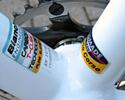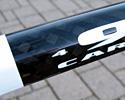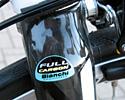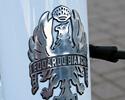
Recently on Cyclingnews.com |
On Test: Bianchi 928 Carbon T-Cube, February 4, 2008
Barloworld's new ride

|
The new Bianchi 928 Carbon T-Cube will be in the public's eye as the historic company makes its return to the top level of the professional peloton with Team Barloworld. Cyclingnews' Gregor Brown heads off for the hills with a Campagnolo-equipped sample on the roads near the company's headquarters.
Bianchi Product Manager Angelo Lecchi and Product Department Manager Lars Svalin announced just three months ago that Bianchi would be replacing Cannondale as the official bike supplier to Barloworld after a one-year hiatus from the uppermost tier of the sport. The Italian Professional Continental team of Claudio Corti will mostly use one of two new carbon frames for 2008, the 928 Carbon T-Cube or the 928 Carbon SL. The latter belongs to Bianchi's 'HoC' (Hors Categorie) and focuses on light weight while the stouter T-Cube is billed as more of an all-arounder. Barlowold will likely save the SL until later this spring for the multi-day tours and Grand Tours but has already received shipments of the T-Cube in its custom colours.
The lugged joints of last year's 928 Carbon L has now given way to tube-to-tube construction on our 928 Carbon T-Cube tester and the bottom bracket shell and chain stays are now more heavily reinforced. According to Svalin, Bianchi consciously sacrificed weight by adding material in those areas to satisfy the needs of team sprinters and classics specialists Baden Cooke and Robbie Hunter.
"Sometimes it is too much about the weight and not about the performance," said Svalin, who insists that the T-Cube achieves the proper balance between the two. "We did some design modifications that maybe added weight but gave better overall performance. The different bottom bracket, and in the head tube area... the chain stay is slightly bigger - or thicker-walled carbon."
Bianchi may not have prioritised saving weight on the new 928 T-Cube but last year's aluminium dropouts have nonetheless been traded for lighter carbon ones that are sandwiched with aluminium plates for protection. Claimed weight is still just 1kg for a bare 55cm frame. The matching fork is monocoque carbon fibre with the exception of the aluminium tips.
Either way, it was initially difficult to concentrate on the bike's guts in light of its classy appearance. Bianchi offers the 928 T-Cube in either white or its more famous celeste colour and both harken to the classic paint schemes of the post-war racing era. Bare clearcoated panels in the top and down tubes highlight the underlying carbon and the familiar Eduardo Bianchi badges on the head and seat tube are a beautiful touch on a modern day racing machine. Perhaps the only aesthetic disappointment is the non-colour coded fork which detracts from what could be a nicely integrated-looking design.
Get up and go
Looks obviously don't tell you anything about how a bike rides so we quickly departed for some good Italian pavement. As promised, the Bianchi 928 T-Cube offers a smart and responsive drivetrain which translated well in both sprints and climbs. The relatively short chain stays and moderately compact frame offered a tight feel as we headed up the Madonna di Ghisallo although we found ourselves wishing just a bit for a slightly longer wheelbase on the other side.
Even so, the 928 Carbon T-Cube frame provided a smooth ride on the flight downhill and handled tight bends and switchbacks ('tornati' as we call them in Italy) with aplomb. Road blemishes were well-damped; while flying down the Colma di Sormano the bike hit a sizeable crack in the road and we pinch-flatted the rear wheel. However, the flat was hardly noticed expect for the hissing coming from behind and we easily guided the bike to a stop some 200 metres later without fear of taking a spill.
Speaking of rear flats, though, that incident did serve to highlight one of our only major gripes with the bike. There isn't sufficient room in between the rear derailleur and relatively large Campagnolo skewer nut for the wheel to slip through. We had to remove the nut completely to get the wheel in or out, thus making our 'quick' release more of a 'slow' release. As you can imagine, that sort of situation can be a disaster on race day and Bianchi recognized that the issue needed to be addressed.
On the bright side, Bianchi's rich history and Lecchi's own experience as a professional on the road have clearly paid dividends in the handling department. The balanced characteristics are only enhanced by the lively feel (which is not a given with carbon frames by any means) and never did we feel the T-Cube was 'dead' or 'invisible'. In fact, the T-Cube does a wonderful job of rolling over the road kilometre after kilometre.
Stuff
Our test bike came with a stacked assortment of Italian goodies including a Campagnolo Record group which performed its job perfectly - no surprise from the company that has been at it for 75 years. The accompanying Eurus G3 clincher wheels were stable and stiff but the braking surface seemed overly soft. Grit became lodged into the braking surface and the pads picked up aluminum flecks, making braking a noisy affair. The grip and stopping power of the Continental Grand Prix 4000 tyres was very good, but be it from bad luck, mechanical gremlins, or otherwise, we suffered more flats than normal.
The Deda Elementi Electa and Forza carbon fiber bar and stem were excellent - when torqued down properly the combination offered a reassuringly solid feel. The half-wrapped bars look great and the ergnonomic tops offer a nice form for gripping but is slick as snot if you're wearing a long sleeve jersey and leaning your elbows on them Michele Bartoli style - definitely not a recommended position. This could be considered a personal preference issue, but we feel the bars should be completely wrapped anyway.
Out back the Deda Elementi Blackstick seat post allowed a position perfectly situated over the bottom bracket, while the extra length of the fi'zi:k Arione saddle allowed for an especially rearward position when having to push hard. It is also worth mentioning that the standard seatpost, while perhaps (but not always) marginally heavier than an integrated design, offers more positioning flexibility and is easier to live with over the long haul, plus the classic configuration suits the looks of the T-Cube quite well.
Another worthy option
We fully realize that a lot of these bike reviews are starting to sound like different versions of the same Mad Libs fill-in-the-blank word game, but as carbon bike technology and design continues to evolve it's honestly become increasingly rare to come across a high-end carbon machine that's actually bad. With that being said, it's also become more difficult for bike manufacturers to make their wares stand out from the crowd.
Be that as it may, the Bianchi 928 Carbon T-Cube still adds itself to the list of capable performers in a crowded market with a competitive weight, refined ride, and time-proven geometry that at least earn it a serious look.
Price: €2115 (frameset only); €5700 (as tested)
Weight: 7.24kg (16.0lb), 55cm frame, as tested, with pedals
Pros: Tight and efficient, classic looks
Cons: Maybe a little excessive for typical consumers, non-colour coded
fork, poor rear dropout design, soft braking surface
Cyclingnews rating: ![]()
More info: www.bianchi.com
Photography
For a thumbnail gallery of these images, click here
Images by Gregor Brown / Cyclingnews.com
- The Bianchi 928 Carbon T-Cube is one of several models that Barloworld will use this season.
- The 928 Carbon T-Cube is part of Bianchi's Born for Performance (B4P) line-up
- A switch from tube-and-luge to tube-to-tube construction makes for additional reinforcement at the bottom bracket shell and a stiffer drivetrain as compared to last year's model.
- Bianchi opts for dual seat stays instead of the increasingly common wishbone design.
- The classic paneled paint scheme reveals the underlying carbon weave.
- The chain stays are thick-walled to beef up the rear end.
- The 928 Carbon T-Cube is supplemented by a full carbon fork.
- The Bianchi head tube badge is a classic touch on a thoroughly modern frame. The crown comes thanks to the permission granted by Queen Margherita, whom Eduardo Bianchi taught to ride a bike.)
- Another badge graces the seat tube.
- The down tube is slightly squared off.
- The barrel adjusters are convenient in theory but somewhat hard to get to while riding.
- The tube-to-tube construction allows for custom sizes for Bianchi's sponsored riders.
- Custom geometries include sloping or standard top tubes depending on team rider preference.
- Frame members are held in a jig for precise alignment during construction
- Mitered tubes are bonded together and then wrapped with additional layers of carbon.
- Finished tube-to-tube construction ready to be painted.
- Stacks of 928 Carbon T-Cube team frames waiting to be painted.
- The 928 Carbon T-Cube is the frame of choice for Team Barloworld's early season.
- The new 928 Carbon T-Cube of Team Barloworld rider Christian Pfannberger.
- Our Bianchi 928 Carbon T-Cube tester came equipped with Campagnolo Record but others build kits are available.
- The rigidity of the Campagnolo Record CT Ultra-Torque crankset complemented the frame well.
- Campagnolo Record D-Skeleton brakes provide the stopping power.
- The Campagnolo Record QS front derailleur…
- …shifts the chain between the standard-sized chainrings.
- The familiar Campagnolo Record rear derailleur performed admirably throughout testing.
- Our test bike came complete with a carbon fiber Deda Electa bar and Forza stem.
- The ergonomically shaped Deda Electa bar looks great only half-taped but is more usable with a full wrap job.
- The four-bolt faceplate offers plenty of clamping power.
- The Campagnolo Eurus G3 clincher wheels offered up a solid feel.
- The 2:1 rear lacing pattern helps equalize spoke tension between the driveside and non-driveside.
- Continental Grand Prix 4000 tyres include a Vectran breaker belt but we still suffered from several flats.
- German rubber for an Italian rig.
- More carbon can be found in the Deda Blackstick seatpost.
- The fi'zi:k Arione Wing Flex saddle naturally comes in matching white.
- The complex-looking Bianchi Dr. Dobermann carbon cage held bottles reasonably well.
- Our 55cm tester weighed a competitive 7.24kg with pedals.
|
Frame: Bianchi 928 Carbon T-Cube |
Shift levers: Campagnolo Record QS Ergopower |








